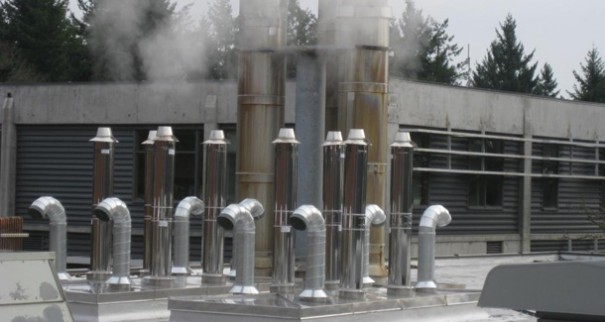This content was published: January 27, 2011. Phone numbers, email addresses, and other information may have changed.
Sylvania Campus upgrades boiler system to increase energy efficiency
Photos and Story by Christine Egan
“Small” is the new “big” in terms of heat plant energy efficiency at Portland Community College’s Sylvania Campus.
Construction crews have installed eight petite Aerco Benchmark condensing boilers to replace part of the aging and monster-sized central plant boiler system that for more than 40 years has provided heat and domestic hot water to the campus’ 13 buildings. The remainder of the old system will stay on campus, serving as a back-up for the new boilers, which are already up and running.

Two of PCC Sylvania’s eight new Aerco boilers. The new boilers – which provide heat and hot water to campus buildings – are significantly more energy efficient.
“The new boilers will enable us to gain a number of energy efficiencies that long-term will reduce both heat costs and carbon emissions – and that puts us closer to reaching the college’s sustainability goals as outlined in its Climate Action Plan,” said Laura Ward, Energy Resource Conservation manager for the college.
The boiler heating system is set up as a “loop” of piping threaded throughout campus, building by building. The process begins at the Heat Plant on the south side of campus. Natural gas provides energy to heat water; for the old boiler system, water was heated to 190 degrees and through a complicated network of piping, valves and heat exchangers, this water is used to heat air and provide hot water in each of Sylvania’s buildings. After traveling the boiler loop system, serving each building, the hot water returns to the Heat Plant at 160 degrees. This process repeats itself multiple times per day. The new system, according to Ward, will allow the college to “reset” the temperature of the heating system loop.

Small and large stacks are visible on the roof of the Heat Plant, stemming from the new and old boilers located below.
“The boilers allow temperatures for the loop to drop into the condensing range,” said Ward, meaning they’re able to work with condensation, capturing heat from it. This reduces the temperature of hot water sent out on the loop cycle; instead of 190 degrees, it can drop as low as 120 degrees and return at 100 degrees or less.
Additionally, the heat and hot water released to each building on campus can be adjusted to that building’s actual need . “The old boiler system couldn’t be manipulated in this way,” said Ward. “Each building got the same regulated blast of heat and hot water, whether needed or not.
“Now we can adjust the energy load delivered, building by building, depending on what the real needs are. This capability, called ‘turn-down,’ will greatly reduce the amount of heat energy lost or wasted,” said Ward.
Another plus is the new boiler system’s “pinch-hit” ability. If the old boiler system malfunctioned, the entire campus was affected. The eight new boilers “cover” for each other; if one breaks down, the others are able to pick up the load.
Finally, the new system is “hybrid” in design; it can be modified to work with still-evolving fuel cell technology for heating and electrical power generation, equipment currently under consideration by the college.
“As we got into the project – down in the tunnels, analyzing the maze of pipes and valves housed there – we were able to diagnose existing weaknesses in the old system and create a game plan for a brand new boiler system that is more effective and energy-efficient,” said Gary Sutton, bond project manager for Sylvania Campus.
The cost of the new boiler system totaled approximately $2 million and came from a variety of sources: bond deferred maintenance funding, PCC’s capital renewal program and a stimulus grant of $350,000. Additionally, the Energy Trust of Oregon awarded PCC an incentive of $96,000 because of energy savings generated by the new system. Anticipated annual savings of the new system are projected at 21,000 therms – a measurement of energy related to natural gas use, roughly estimated at $1 per therm.
“The boiler project is an outstanding example of cooperation, collaboration and leveraging,” said Linda Gerber, Ed.D., president of Sylvania Campus. “The college’s Facilities Management Services department, the bond team, our architects, engineers and construction teams joined forces – and budgets – to implement what was a very complicated task: To replace the heart of the heating system for an entire campus while continuing to provide heating and cooling, with minimal disruption.
“I’m proud of what they’ve accomplished – and of how this supports the Climate Action Plan and campus E6/NetZero goals,” said Gerber.
The boiler system replacement is one part of a multi-year, multi-phase construction project at Sylvania that will result in a modernized, energy-efficient campus in the next five to seven years. Funding for this comes in part from a $374 million bond measure that voters approved in 2008 to upgrade existing buildings, expand work-force training facilities and add needed buildings at PCC’s campuses throughout the district.
In 2009, PCC unveiled its Climate Acton Plan, detailing how the college will reduce its greenhouse gas emissions from 2006 levels by 40 percent in 2030 and by 80 percent in 2050. To support these goals, the Sylvania Campus launched its E6/NetZero project which includes the boiler system replacement.
The E6 – which stands for Energy Creation/Energy Conservation/Environmental Stewardship/Employment Stimulus/Education/Efficient and Effective Use of Funds – NetZero project is anticipated to eventually meet all the campus’ energy demands with energy generated on-site; reduce potable water consumption by 50 percent; save millions annually in energy costs; and create a “living laboratory” for its green technology education programs, faculty and students.
For more information about PCC’s sustainability initiatives, visit: https://www.pcc.edu/about/sustainability/


Wonderful blog post, stick with it!